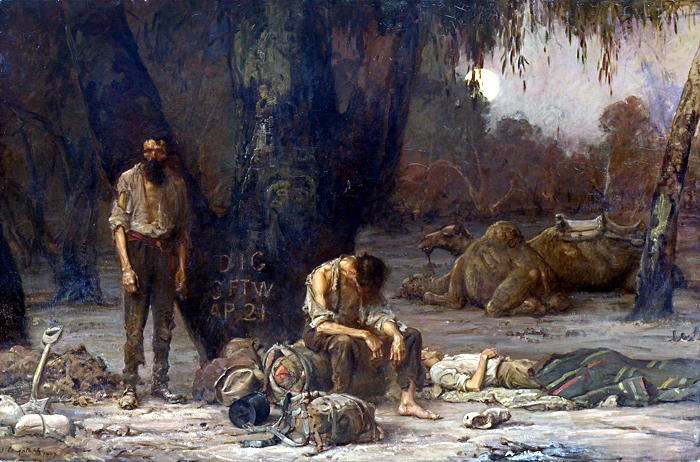234-The Dig Tree
Futility Closet
Greg Ross
4.8 • 748 Ratings
🗓️ 28 January 2019
⏱️ 34 minutes
🧾️ Download transcript
Summary

In 1860 a party of explorers set out to traverse the Australian continent, but bad management and a series of misfortunes sent it spiraling toward tragedy. In this week's episode of the Futility Closet podcast we'll tell the story of the Victorian Exploring Expedition and its dramatic climax at Cooper's Creek.
We'll also try to validate Archimedes and puzzle over an unlucky thief.
Intro:
In 1990 Jon Perez Laraudogoitia wrote a philosophy article that compelled its own acceptance.
In 1976 architect Robert Venturi found a way to commemorate a house with no surviving description.
Sources for our story on the Burke and Wills expedition:
Alan Moorehead, Cooper's Creek, 1963.
Sarah P. Murgatroyd, The Dig Tree, 2002.
Dave Phoenix, Following Burke and Wills Across Australia: A Touring Guide, 2015.
Ian Clark and Fred Cahir, The Aboriginal Story of Burke and Wills: Forgotten Narratives, 2013.
A.W. Howitt, et al., "Exploring Expedition From Victoria to the Gulf of Carpentaria, Under the Command of Mr. Robert O'Hara Burke," Journal of the Royal Geographical Society of London 32 (1862), 430-529.
The Diary of William John Wills.
William John Wills, A Successful Exploration Through the Interior of Australia: From Melbourne to the Gulf of Carpentaria, 1863.
Dave Phoenix, "Burke and Wills -- An Overview of the Expedition, Its Preparation, Planning and Outcomes," Queensland History Journal 21:8 (2012), 497.
Jessica Campion, "Burke and Wills: Botany's Untold Success Story," Australian Geographic, July 27, 2011.
Bernie Joyce and Doug McCann, "The Scientific Legacy of Burke & Wills," Australasian Science 32:5 (June 2011), 29-31.
Sally Woollett, "Thiamine and the Dig Tree Tragedy," Chemistry in Australia 78:10 (November 2011), 4.
John W. Earl and Barry V. McCleary, "Mystery of the Poisoned Expedition," Nature 368:6473 (April 21, 1994), 683.
Deirdre Slattery, "If Burke Had Been a Naturalist ...: Telling and Re-Telling National Narratives," Australian Journal of Outdoor Education 8:2 (2004), 13-21.
Peter Daszak, "A Last Waltz for Burke, Wills, and King," EcoHealth 13:4 (December 2016), 821–823.
"Burke & Wills: From Melbourne to Myth," [Melbourne] Herald Sun, Sept. 24, 2002, 34.
Carolyn Webb, "Exploring the Myth," The Age, Aug. 26, 2002, 3.
"Memoirs of the Late Leaders of the Exploring Expedition," Sydney Morning Herald, Nov. 19, 1861, 2.
"Memorandum on the Recent Journeys of Exploration Across the Continent of Australia," Sydney Morning Herald, Dec. 20, 1861, 7.
"The Australian Exploring Expedition," North Wales Chronicle, Feb. 22, 1862.
"Australian Explorations," Newcastle Courant, May 23, 1862.
Richard Garnett, "Burke, Robert O'Hara," Oxford Dictionary of National Biography, Sept. 23, 2004.
C.A. Harris, "Wills, William John," Oxford Dictionary of National Biography, Sept. 23, 2004.
Burke and Wills Collection, National Museum Australia.
Listener mail:
Wikipedia, "Concentrated Solar Power" (accessed Jan. 17, 2019).
Wikipedia, "Ivanpah Solar Power Facility" (accessed Jan. 17, 2019).
Adam Clark Estes, "How the World's Largest Solar Plant Wants to Fix Its Fried Bird Problem," Gizmodo, Aug. 19, 2014.
Associated Press, "BrightSource Solar Plant Sets Birds on Fire as They Fly Overhead," Aug. 18, 2014.
Ian Sample, "Doubt Cast on Archimedes' Killer Mirrors," Guardian, Oct. 23, 2005.
Jeremy Hsu, "Archimedes' Flaming Death Ray Was Probably Just a Cannon, Study Finds," Christian Science Monitor, June 29, 2010.
Thomas W. Africa, "Archimedes Through the Looking-Glass," The Classical World 68:5 (February 1975), 305-308.
Josh Clark, "What Was Archimedes' Death Ray?" How Stuff Works (accessed Jan. 17, 2019).
"Archimedes Death Ray," student experiment, Product Engineering Processes, MIT, October 2005.
"Archimedes Death Ray: Testing With MythBusters," Product Engineering Processes, MIT, October 2005.
Renee Montagne, "Was Archimedes' Mirror Real?" Morning Edition, National Public Radio, July 25, 2018.
This week's lateral thinking puzzle was devised by Sharon. Here's a corroborating link (warning -- this spoils the puzzle).
You can listen using the player above, download this episode directly, or subscribe on Google Podcasts, on Apple Podcasts, or via the RSS feed at https://futilitycloset.libsyn.com/rss.
Please consider becoming a patron of Futility Closet -- you can choose the amount you want to pledge, and we've set up some rewards to help thank you for your support. You can also make a one-time donation on the Support Us page of the Futility Closet website.
Many thanks to Doug Ross for the music in this episode.
If you have any questions or comments you can reach us at [email protected]. Thanks for listening!
Transcript
Click on a timestamp to play from that location
| 0:00.0 | Welcome to the Futility Closet Podcast, forgotten stories from the pages of history. |
| 0:14.3 | Visit us online to sample more than 10,000 quirky curiosities from an article's bootstraps to a house's ghost. This is episode 234. I'm Greg Ross. |
| 0:24.4 | And I'm Sharon Ross. In 1860, a party of explorers set out to traverse the Australian continent, |
| 0:30.8 | but bad management and a series of misfortune sent it spiraling toward tragedy. In today's show, |
| 0:37.1 | we'll tell the story of the |
| 0:38.3 | Victorian Exploring Expedition and its dramatic climax at Cooper's Creek. We'll also try to |
| 0:44.7 | validate Archimedes and puzzle over an unlucky thief. |
| 1:03.5 | Australia's first European settlers arrived in 1788, and by 1860, Sydney, Melbourne, and Adelaide were thriving. |
| 1:09.1 | Melbourne, in particular, had grown into a proper city of 140,000 people, in part because a recent gold rush had drawn a thousand ships a year to its |
| 1:11.6 | shores. Flushed with wealth and confidence, the citizens of Victoria turned their attention |
| 1:15.8 | to the hot, dry interior of the continent, which was still a huge blank on the map, 1600 miles |
| 1:21.0 | long by 800 wide. Half a dozen expeditions had set out to explore it and had come back defeated. |
| 1:27.2 | One explorer, Charles |
| 1:28.2 | Sturt, had got as far north as the 25th latitude, but had run into a forbidding desert. He |
| 1:32.9 | reported that an explorer would face unbearable heat there in the summer months, thirst, hunger, |
| 1:37.3 | and the danger of scurvy. He wrote, depend upon it, I would not have retreated from such a |
| 1:41.4 | position for a trifle, but you can form no idea of that region. |
| 1:45.2 | But there was mounting pressure to find a way through it. |
| 1:47.5 | Ships still took two months to carry messages by sea from southeastern Australia to Britain. |
| 1:52.2 | If someone managed to cross the continent from south to north, then it might be possible to |
| 1:56.1 | build a telegraph line that linked Adelaide to a cable in Java. |
| 1:59.7 | That would enable the settlers to communicate with |
... |
Please login to see the full transcript.
Disclaimer: The podcast and artwork embedded on this page are from Greg Ross, and are the property of its owner and not affiliated with or endorsed by Tapesearch.
Generated transcripts are the property of Greg Ross and are distributed freely under the Fair Use doctrine. Transcripts generated by Tapesearch are not guaranteed to be accurate.
Copyright © Tapesearch 2025.

